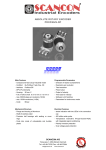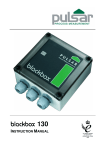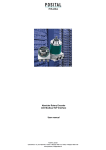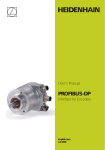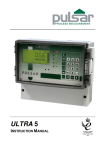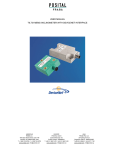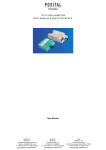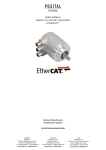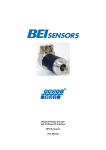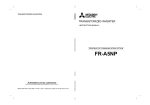Download Absolute Rotary Encoder with Profibus-Interface OCD
Transcript
® PROCESS FIELD BUS Absolute Rotary Encoder with Profibus-Interface OCD-DPB1B-XXXX-XXXX-0CC Add-on to user manual UME-B1DP DPV2-functionality Contents General ............................................................ 3 4 Acyclic services............................................ 13 1.1 Clock-cycle-synchronous communication........ 3 5 Error messages / diagnostics ..................... 13 1.2 Slave-to-Slave communication ........................ 3 5.1 Profibus diagnostics ....................................... 13 2 2.1 Start-up of the encoder .................................... 4 5.2 Status indication by the LEDs in the connection cap........................................................................ 13 2.2 Standard telegram 81....................................... 5 5.3 Error codes in G1_XIST2 ............................... 14 3 6 1 Data exchange isochronous mode............... 4 Parameters ...................................................... 8 Configuring with STEP 7.............................. 15 3.1 Parameters – Overview.................................... 8 6.1 Installing the GSD file..................................... 15 3.2 User parameter data ........................................ 8 6.2 Configuring the encoder ................................. 16 3.3 Parameters for the isochronous mode........... 10 6.3 Telegram selection ......................................... 17 3.4 Slave-to-slave communication ....................... 12 6.4 Setting the parameters ................................... 18 Imprint POSITAL GmbH Carlswerkstr. 13c D-51063 Cologne P.O. Box 80 03 09 D-51003 Köln Telephone ++49/(0) 221/ 96213-0 Fax ++49/ (0) 221/ 96213-20 Internet http://www.posital.de E-mail [email protected] this documentation without written approval by the company POSITAL GmbH. Specifications are subject to change without notice Technical specifications, which are described in this manual, are subject to change due to our permanent strive to improve our products. Copyright The company POSITAL GmbH claims copyright on this documentation. It is not allowed to modify, to extend, to hand over to a third party and/or to copy Page 2 Publication: Version: Author: Add-on UME-BXDP – Profibus DPV2 Jan. 2007 1.1 Dirk Jüngling Version 01/07 1 General The latest version of the POSITAL absolute encoder with profibus interface supports the new profibus functionalities clock-cycle-synchronous communication and slave-to-slave communication. 1.1 Clock-cycle-synchronous communication The isochronous communication forms the basis for the synchronization of several drives. With this new functionality the Profibus-Slaves may synchronize to a clock signal sent by the Profibus master as global control command (GC). By defining the instant for the position value latch (parameter TI) within the bus cycle (TDP) it is possible to GC acquire the actual position values of several axes precisely at the same time. Furthermore setpoints can take effect precisely at the same time at different axes. To define this instant within the bus cycle the parameter TO is used. GC GC TDP TDP TDX S1 S2 S3 TDX S4 MSG Res./ GC S1 S2 S3 S4 MSG Res./ GC TOmin TI TO 1.2 Slave-to-Slave communication To reduce the response time of the application, slave-to-slave communication was implemented in Profibus DP V2. It renders it possible for one slave to directly receive the output values of another slave. Thereby Slaves can receive the actual values of other slaves in the same bus cycle and can use them as reference values. A slave device that Version 01/07 makes its values available for other slaves is called „publisher“. The slave device, which receives this value, is called „subscriber“. The „slave-to-slave“ data transmission has to be initiated by a master device, but the transfer takes place in only one bus cycle. Add-on UME-BXDP – Profibus DPV2 Page 3 2 Data exchange isochronous mode To use the new functionality of the encoder the GSD-file „FRAB06DF.GSD“ has to be installed. If the device has been previously used with another GSD-file, the power supply has to be switched off and on again after changing the GSD. The example in chapter 6 describes how to install and configure the encoder. 2.1 Start-up of the encoder The encoder will pass the following phases before the synchronization is achieved: 2.1.1 Slave-Configuration Parameter and configuration data are transferred from the master to the slave. The structure of the parameters (and the possibilities of programming the device) are described in chapter 3. With the current encoder version the only possible configuration is standard telegram 81 (defined in the PROFIdrive Profile). This telegram is described in chapter 2.2. standard telegram output data input data configuration (special configuration identifier) 81 2 words 6 words 0xC3,0xC1,0xC5,0xFD,0x00,0x51 2.1.2 Synchronizing to the cycle Global Control As soon as the slave application detects the status „operate“ and receives valid data-exchangetelegrams a first attempt to synchronize to the cycle global control is started. The cycle time used is the bus cycle time TDP (isochronous parameters, cp. 3.3.2), the width of the tolerance window is a multiple of the width TPLL_W (cp. 3.3.8) as both of them were transmitted by the PLC in the parameterization data. During the synchronization the bus cycle time TDP is adapted to the real bus cycle, the tolerance window is minimized until the width TPLL_W (cp. 3.3.8) is reached. After successful synchronization to the cycle Global Control the slave application starts the monitoring of the clock pulse. A detailed description is contained in the PROFIdrive Profile. If the maximum permissible number of clock pulse failures is exceeded, the error bit in the status word is set, the corresponding error code (cp. 5.3) is transferred. The slave will directly start the attempt to achieve a new synchronization to the clock pulse. 2.1.3 Synchronizing of the slave application to the master’s sign of life If the synchronization to the clock pulse has been successful, the slave application tries to synchro- Page 4 nize to the master’s sign of life. An increase of the master’s sign of life once per cycle of the master Add-on UME-BXDP – Profibus DPV2 Version 01/07 application is expected. The cycle time of the master application has to be transferred to the slave via the parameter TMAPC (cp. 3.3.3). As soon as the master transmits the first master life sign that is not zero the slave starts the synchronization. If the value range of the master’s sign of life has been traversed once without error, the synchronization is considered as successful and the slave application starts monitoring the master’s sign of life. A de- tailed description of this process can be found in the PROFIdrive Profile. If a „life-sign-error“ occurs after successful synchronization, the error bit in the status word is set, the corresponding error code (cp. 5.3) is transferred and slave’s sign of life is reset to zero. The slave immediately starts a new synchronization attempt. 2.1.4 Synchronizing of the master application to the slave’s sign of life After successful synchronization of the slave application to the master’s sign of life the slave sets the slave’s sign of life to a value <> 0 and increases it every bus cycle. Now the master application can synchronize to the salve’s sign of life. 2.1.5 Cyclic operation During cyclic operation the slave application monitors the master’s sign of life. If there is a sign-oflife-failure the slave application automatically tries to synchronize again. As long as there is no failure the slave’s sign of life is increased in every bus cycle and can be monitored by the master application. 2.2 Standard telegram 81 In cyclic operation standard telegram 81 (cp. PROFIdrive Profile) is used: Output data (Master -> Encoder) 2 x 16 Bit (consistent) STW2 G1_STW1 Input data (Encoder -> Master) 2 x 16 Bit + 2 x 32 Bit (consistent) ZSW2 Version 01/07 G1_ZSW1 G1_XIST1 Add-on UME-BXDP – Profibus DPV2 G1_XIST2 Page 5 STW2 (16 Bit): Master’s sign-of-life 4-Bit-counter, left justified. The master application starts the sign of life with any value between 1 and 15. The master increases the counter in every cyX X X X Counter 0 0 0 0 0 0 0 0 0 0 cle of the master application. Valid values for the master’s sign of life are 1 to 15, “0” indicates an error and is left out in normal operation. 0 Not used ZSW2 (16 Bit): Slave’s sign of life 4-Bit-counter, left justified. The slave application starts the sign of life with any value between 1 and 15 after successful synchronization to the clock pulse. The counter is increased by the slave appli- X X X 0 X Counter 0 0 0 0 0 0 0 0 0 0 cation in every DP-cycle. Valid values for the slave’s sign of life are 1 to 15, “0” indicates an error and is left out in normal operation. 0 0 Not used G1_STW1 (16 Bit): Sensor control word Bit Value Meaning 0 .. 10 Comments Reserved, currently not used 11 0/1 „Home position mode“ 12 1 Set preset / request shift Preset (resp. shift) is set when changing this Bit to “1” (rising edge). Default preset value (shift): 0 13 1 Request absolute value cyclically Request of additional cyclic transmission of the absolute actual position in G1_XIST2. If no other data needs to be transferred due to commands or errors the absolute position value will be transmitted automatically. 14 1 Activate parking sensor If the “activate parking sensor” bit is set, the encoder transmits no error messages. 15 1 Acknowledging a sensor Request to acknowledge / reset a sensor error error Page 6 Specifies if the position value shall be set to a previously programmed absolute value or shifted by this value. 0: set home position / preset (absolute) 1: shift home position / preset (relative) Add-on UME-BXDP – Profibus DPV2 Version 01/07 G1_ZSW1 (16 Bit): Sensor status word Bit Value Meaning 0 .. 10 Comment Reserved, currently not used 11 Acknowledgement sensor error in process Is set if the reset of a sensor error (after acknowledging) takes longer than one bus cycle. 12 1 Set preset / shift reference point executed Acknowledgement for “set preset / request shift” 13 1 Transmit absolute value cyclically Acknowledgement for “request absolute value cyclically“ 14 1 Parking sensor activated Acknowledgement for “activate parking sensor“. The encoder transmits no error messages. 15 1 Sensor error Indicates a sensor error. A device specific error code is transmitted in G1_XIST2. G1_XIST1 (32 Bit): Actual position value In G1_XIST1 the actual position value is transmitted left justified. The shift factor (number of bits the G1_XIST2 (32 Bit): Actual value 2 / error codes In G2_XIST2 an additional absolute actual position value is transmitted (right justified). The shift factor can be read with the acyclic parameter P979. In Version 01/07 value has been shifted) can be read with the acyclic parameter P979. case of an error a device specific error code is transmitted. Add-on UME-BXDP – Profibus DPV2 Page 7 3 Parameters Different parameters and configuration options are described in the following. 3.1 Parameters – Overview Parameters are transmitted in the parameter telegram as so-called „Structured_Prm_Data“- blocks: Byte-No. Parameter 1-7 Profibus Standard Parameter 8-10 DPV1-Bytes Data type Details Profibus Standard 11-14 Blockheader User-Parameter 4 x Unsigned8 15 Bit 0 Code sequence Bit 3.2.1 15 Bit 1 Activate scaling / preset / counting direction Bit 3.2.2 Bit 15 Bit 3 Scaling function 15 Bit 2, 4 - 7 Reserved 16 - 19 Measuring units per revolution Unsigned32 3.2.3 20 - 23 Total measuring range Unsigned32 3.2.4 24 Maximum failures master’s sign of life Unsigned8 3.2.5 25 - 31 Reserved 32 - 35 Blockheader isochronous parameters 3.2.2 Currently not used Currently not used 4 x Unsigned8 36 Version Unsigned8 37 – 40 TBASE_DP Unsigned32 3.3.1 41 - 42 TDP Unsigned16 3.3.2 43 TMAPC Unsigned8 3.3.3 44 - 47 TBASE_IO Unsigned32 3.3.4 48 – 49 TI Unsigned16 3.3.5 50 – 51 TO Unsigned16 3.3.6 52 - 55 TDX Unsigned32 3.3.7 56 - 57 TPLL_W Unsigned16 3.3.8 58 - 59 TPLL_D Unsigned16 3.3.9 3.2 User parameter data The following device specific parameters can be used to adapt the encoder to particular applications: Page 8 Add-on UME-BXDP – Profibus DPV2 Version 01/07 3.2.1 Code sequence The parameter “code sequence” defines the counting direction of the position value. The code increases when the shaft is rotating clockwise (CW) or counter-clockwise (CCW) (view onto the shaft). The code sequence is defined in bit 0 of octet 15. Octet 15 Bit 0 Direction of rotation when viewing the shaft Code 0 Clockwise (CW) Increasing 1 Counter-clockwise (CCW) Increasing 3.2.2 Scaling / Preset / Counting direction The functions „preset value“, „scaling function“ and „code sequence“ can be enabled or disabled with bit 1 in octet 15. If the device is used with the minimum TI of 125 µs these functions have to be disabled! If these functions are enabled certain rules have to be observed: TI has to be at least 375 µs. The time between setpoint transfer (TO) and position value latch (TI) has to be at least 375 µs. Octet 15 Bit 1 Scaling/preset/counting direction 0 disabled 1 enabled To use the scaling function, additionally bit 3 in octet 15 has to be set to 1 (default setting): Octet 15 Bit 3 scaling function 0 disabled 1 enabled 3.2.3 Measuring units per revolution The parameter “measuring units per revolution” is used to program the desired number of steps in one revolution. If the value exceeds the basic (physical) resolution of the encoder, the output code would no longer be single-stepped. In that case the encoder indicates a parameter error (LED) and it will not enter the data exchange mode. Octet 16 17 18 19 Bit 31 – 24 23 – 16 15 - 8 7–0 Data 231 to 224 223 to 216 215 to 28 27 to 20 desired measuring units per revolution Version 01/07 Add-on UME-BXDP – Profibus DPV2 Page 9 3.2.4 Total measuring range Octet 20 21 22 Bit 31 – 24 23 – 16 15 - 8 Data 2 31 to 2 24 2 23 to 2 16 2 15 23 to 2 7-0 8 27 to 20 desired total measuring range in steps The parameter “total measuring range” is used to adapt the measuring range of the encoder to the real measuring range of the application. The encoder counts up until the position value has reached the programmed total resolution and starts with 0 again. Example: 100 steps are programmed for each revolution (parameter “measuring units per revolu- tion”) and the total resolution is set to 12800. Then the encoder counts up to 11799, starts with “0” again after 128 revolutions, counts up to 11799, and so on. With many software tools it is necessary to divide the value into high and low word (please refer to the user manual). Furthermore the following rule has to be observed: If “steps per revolution” are set to “n” the parameter total resolution must not cause periods longer than the maximum (physical) number of revolutions (see type label), i.e. that the programmed total resolution of a 4096 revolution multiturn encoder must be less than 4096 x the programmed number of steps per revolution: Total resolution < measuring units per revolution x real number of revolutions (physical) If this rule is disregarded the encoder will indicate a parameter error and it will not enter the data exchange mode. 3.2.5 Maximum failures master’s sign-of-life Parameter-byte 24 can be used to program the number of allowed failures of the master’s sign of life to a value different from the default 1. 3.3 Parameters for the isochronous mode Some parameters needed for the isochronous mode have to be set by the user, others are calculated automatically by the configuration tool (e.g. the SIMATIC Manager). The different parameters are described in the following: 3.3.1 TBASE_DP Time basis of TDP (DP cycle time) Unit: 1/12 µs Page 10 Set to 125 µs in the GSD file. Add-on UME-BXDP – Profibus DPV2 Version 01/07 3.3.2 TDP DP cycle time Unit: TBASE_DP The DP cycle time consists of the following parts: Duration of the cyclic services; depends on the number of slaves and telegram lengths. Duration reserved for the acyclic services: depends on the maximum length of the DPV1 telegrams. Duration until a new clock pulse is generated: GAP, token passing, reserve, Global_Control. The DP cycle time resulting from this is offered as default when configuring by the appropriate configuration tools. However, it is possible to enter higher values to adapt the cycle time to the application’s needs. The maximum value TDP for the encoder is 32 ms, the minimum value (theoretical) is 500 µs. - 3.3.3 TMAPC Master application cycle. Multiple of TDP, used to evaluate the master’s sign of life. 3.3.4 TBASE_IO Time base of TI and TO (instants in time of the actual value acquisition, setpoint transfer) Unit: 1/12 µs Set to 125 µs in the GSD file. 3.3.5 TI The instant TI is used to synchronize the actual value acquisition in all slaves. The time TI refers to the end of the DP-cycle. Unit: TBASE_IO The following rules have to be observed: The minimum time for TI (GSD parameter TI_MIN) of 125 µs is only valid, if the functions scaling/preset/counting direction are disabled. Version 01/07 If the scaling function is used, TI has to be at least 375 µs. Further on there has to be a minimum time between the instant of setpoint transfer (defined by TO) and the instant of actual value acquisition (defined by TI). This minimum time interval is 125 µs if the scaling function is disabled and 375 µs if the scaling is enabled. Add-on UME-BXDP – Profibus DPV2 Page 11 3.3.6 TO The instant TO is used to synchronize the setpoint transfer in all slaves. The time TO refers to the start of the DP-cycle. Unit: TBASE_IO The times chosen have to comply with a minimum time between the instant of setpoint transfer (preset value) and the next instant of actual value ac- quisition (position value latch), because some internal calculations are necessary This minimum time is 125 µs if the scaling function is disabled and 375 µs if the scaling is enabled. Additionally the following rule has to be met: TO > TDX + TO_MIN 3.3.7 TDX Data_Exchange_Time Unit: 1/12 µs The duration of the Data_Exchange services, mainly dependent on telegram length, baud rate and number of nodes. 3.3.8 TPLL_W PLL window. Unit: 1/12 µs The window specified by the parameter TPLL_W defines the maximum permissible jitter on the bus. Clock pulses within this tolerance window are recognized as valid. When synchronizing to the clock pulse the encoder starts with a multiple of the window width and scales it down until the programmed width is reached. If the parameterized TPLL_W is lower than the minimal setting applicable for this encoder (1 µs) the minimal setting will be used automatically. 3.3.9 TPLL_D Delay time of the clock signal. Unit: 1/12 µs Is internally added to the cycle time TDP by the encoder. 3.4 Slave-to-slave communication If the slave-to-slave communication is to be used, the slave-to-slave communication channels have to be defined in the hardware configuration (in the configuration tool, e.g. the SIMATIC Manager). The encoder is a so-called publisher, which means that slaves with the so-called “subscriber” function- Page 12 ality can receive the actual values from the encoder directly. For detailed descriptions how to configure the slave-to-slave communication channels refer to the user manual of the configuration software. Add-on UME-BXDP – Profibus DPV2 Version 01/07 4 Acyclic services The following acyclic parameters are supported (read only): Parameter Nr. Description Data type R/W 918 Profibus address Unsigned16 R 922 Telegram type Unsigned16 R 964 Device identification Array[n] Unsigned16 R 965 Profile Number Octet String 2 R 979 Sensor format Array[n] Unsigned32 R For detailed descriptions: refer to PROFIdrive Profile. 5 Error messages / diagnostics 5.1 Profibus diagnostics The encoder supports 6 profibus standard diagnostic bytes: Diagnostic function Data type Diagnostics – octet number Station status 1 (refer to Profibus standard) Octet 1 Station status 2 (refer to Profibus standard) Octet 2 Station status 3 (refer to Profibus standard) Octet 3 Diagnostic master address Octet 4 Profibus identification number Octet 5, 6 5.2 Status indication by the LEDs in the connection cap Two LEDs are implemented in the connection cap. They optically indicate the status of the encoder in the profibus network: Version 01/07 Add-on UME-BXDP – Profibus DPV2 Page 13 No. Red LED Green LED Status / possible cause 1 Dark Dark No power supply 2 Bright Bright Encoder is ready for operation but it has not received any configuration data after power on. Possible causes: address setting incorrect, bus lines not connected correctly. 3 Bright Flashing Parameter or configuration error. The encoder receives configuration or parameter data with incorrect length or inconsistent data. Possible cause: parameter value “total measuring range” too high 4 Flashing Bright The encoder is ready for operation but not addressed by the master (e.g. incorrect address in configuration). 5 Bright Dark Encoder has not received any data for a longer period (about 40 sec.). Possible cause: bus line has been interrupted. 6 Dark Bright Normal operation in data exchange mode. 5.3 Error codes in G1_XIST2 Encoder errors are indicated by setting an error bit in the sensor status word (bit 15). The corresponding error codes are transmitted in G1_XIST2: Error code (hex) Error Description 0F01 Command not supported The requested command (e.g. request in the control word) is not supported by the encoder 0F02 Master-Life-Sign Fault Is set if the maximum permissible number of failures of the master’s sign of life is exceeded (only set after the encoder once has been synchronized to the master’s sign of life successfully). As the encoder immediately tries to achieve synchronization again, the synchronization might be running when the error is observed. The encoder keeps reporting the error 0F04 PLL Synchronization fault until it was set back with the appropriate command. Page 14 Is set if the maximum permissible number of failures of the clock pulses is exceeded (only set after the encoder once has been synchronized to the clock pulse successfully). As the encoder immediately tries to achieve synchronization again, the synchronization might be running when the error is observed. The encoder keeps reporting the error until it was set back with the appropriate command. Add-on UME-BXDP – Profibus DPV2 Version 01/07 6 Configuring with STEP 7 6.1 Installing the GSD file If FRABA encoders are used for the first time it is necessary to install the GSD file („FRAB06DF.gsd“) to take over the encoder into the hardware catalogue of the tool: Choose “Install New GSD” in the “HW Config”window of the project (menu item “Options”) and select the GSD-file (“FRAB06DF.gsd”). The GSD file is available from FRABA. After successful installation of the GSD file the encoder can be found in the hardware catalogue in “PROFIBUS-DP” – “Additional Field Devices” – “Encoders” - “FRABA Encoder”. Version 01/07 Add-on UME-BXDP – Profibus DPV2 Page 15 6.2 Configuring the encoder After inserting the Profibus master system into the hardware configuration (“Insert” – “Master System”) the FRABA encoder can be chosen from the hardware catalogue and added to the profibus network: Select the device “FRABA Encoder” and drag it with the mouse to the network (or choose the network and double click the “FRABA encoder”). Now the slave address has to be entered (has to be equal to the address setting in the connection cap). Page 16 Add-on UME-BXDP – Profibus DPV2 Version 01/07 6.3 Telegram selection After the encoder has been added to the profibus network, the telegram type can be chosen. In the current version only standard telegram 81 is sup- Version 01/07 ported. To choose this telegram drag the module “Telegramm 81” to slot 1 in the displayed configuration table of the encoder. Add-on UME-BXDP – Profibus DPV2 Page 17 6.4 Setting the parameters 6.4.1 User Parameter Double click the encoder. The dialog “Properties – DP slave“ appears. Choose the tab “Parameter Assignment” to edit the parameters. Now the user parameters (cp. 3.2) can be edited under “Device-specific parameters”. Page 18 Add-on UME-BXDP – Profibus DPV2 Version 01/07 6.4.2 Parameters for the isochronous mode First of all the constant bus cycle has to be activated in the profibus network (the master has to support the "constant bus cycle time" function): In the Network view, PROFIBUS subnet. double-click on the In the Properties dialog box ("Network Settings" tab), select the "DP" profile and click the "Options" button. Version 01/07 Add-on UME-BXDP – Profibus DPV2 Page 19 In the "Constant Bus Cycle Time" tab, activate the constant bus cycle set the constant bus cycle time behavior that is appropriate for your application. After the general network settings have been finished, double click the slave (encoder) whose parameters shall be set and select the tab “Clocking”. Activate “Synchronize DP Slave with DP cycle”. Choose the appropriate times for TI and TO. Please observe the rules in chapter 3.3.5 and 3.3.6. After all Slaves have been configured and all parameters have been set, the general parameters for the whole network (e.g. “Constant DP cycle”) should be checked once more (and adapted if necessary). Page 20 Add-on UME-BXDP – Profibus DPV2 Version 01/07






















